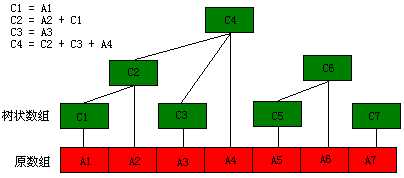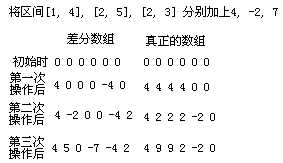标签:color prefix als 技术 证明 lin win32 set name
树状数组是一种常用的数据结构,能够在O(log2n)的时间内进行单点修改和求前缀和。因为代码量小、常熟小往往在某些应用中快于线段树(当然有些问题是不能呢用树状数组完成的)。
方法1:用一个数组,O(1)修改, O(n)查询
方法2:求前缀和,O(n)修改,O(1)查询
以上两种方法卡一卡就TLE了。
树状数组就平衡了一下这两种方法,修改的时候多修改一点,查询的时候多算一点。
为了清楚地明白树状数组是如何运作的,我们实现定义 lowbit(x) 是写成2进制后的x中最后一位1。例如(10)10 = (1010)2,则lowbit(10) = (10)2 = (2)10.
树状数组本质上就是一个长度为n的数组,但是它的每一个位置管辖另一些位置(就是它们的和),对于一个节点i,它的数据同时会被加在节点(i + lowbit(i))上。例如下面这幅图。

至于计算这个lowbit通常是用这么一个快捷的方法:
1 #define lowbit(x) ((x) & (-x))
对于修改操作,就不断去更新管辖当前节点的节点,直到超出范围。
1 inline void add(int idx, LL val) { 2 for(; idx <= s; idx += lowbit(idx)) 3 a[idx] += val; 4 }
现在证明修改操作是O(log2n)的。
1) 当 idx 写成2进制后,1的个数不为1时,每次 idx += lowbit(idx) 时,至少有1个1进位,显然至多log2idx次这样的操作idx写成二进制后就只有1个1了(1 的个数只会减少不会增加)
2) 当 idx 写成2进制后,1的个数为1时,显然lowbit(idx) = idx,所以每次加倍,但是又不能超过n,最多进行log2n次这样的操作。
所以修改操作的时间复杂度时O(log2n)。
观察上面,可以发现一个有趣的结论,树状数组的一个节点i存的值,恰好是原数组中lowbit(i)个连续的元素和的和。
所以求前缀和的操作,就向前依次去加它没有算到的原数组的数(不是暴力,是直接加树状数组中节点的值)
1 inline LL getSum(int idx) { 2 LL rt = 0; 3 for(; idx; idx -= lowbit(idx)) 4 rt += a[idx]; 5 return rt; 6 }
对于求任意一段区间的和就前缀和减减就好了。
这个似乎不是树状数组的本职工作,但还是可以做的。
差分是一个离线的"算法"吧,能够支持O(1)修改,O(n)查询(但是只能在最后查询)。
差分数组满足一个性质,就是位置i的前缀和是在它真正的值。(差分数组秋求前缀和后得到的是原数组)
不懂差分数组的就看张图吧:

既然差分数组能够快速地进行区间修改(本质上时单点修改),求单点是靠求前缀和实现。而树状数组支持单点修改和快速求前缀和,于是用树状数组维护差分数组就能快速做到单点查询和区间修改。
也许你认为线段树可以完成,但是对于这种水题不想出动线段树(懒得写),这时就可以考虑一下树状数组。
树状数组可以优秀地利用差分来求单点,所以先考虑暴力用差分求前缀和(考虑差分数组每个位置被计算的次数)。

这个还可以化简原式 。然后发现这两个都可以用树状数组维护,然后对于任意区间减一减就好了。
。然后发现这两个都可以用树状数组维护,然后对于任意区间减一减就好了。
1 /** 2 * Codevs 3 * Problem#1082 4 * Accepted 5 * Time:430ms 6 * Memory:11240k 7 */ 8 #include <iostream> 9 #include <cstdio> 10 #include <ctime> 11 #include <cmath> 12 #include <cctype> 13 #include <cstring> 14 #include <cstdlib> 15 #include <fstream> 16 #include <sstream> 17 #include <algorithm> 18 #include <map> 19 #include <set> 20 #include <stack> 21 #include <queue> 22 #include <vector> 23 #include <stack> 24 #ifndef WIN32 25 #define Auto "%lld" 26 #else 27 #define Auto "%I64d" 28 #endif 29 using namespace std; 30 typedef bool boolean; 31 const signed int inf = (signed)((1u << 31) - 1); 32 const signed long long llf = (signed long long)((1ull << 63) - 1); 33 const double eps = 1e-6; 34 const int binary_limit = 128; 35 #define smin(a, b) a = min(a, b) 36 #define smax(a, b) a = max(a, b) 37 #define max3(a, b, c) max(a, max(b, c)) 38 #define min3(a, b, c) min(a, min(b, c)) 39 template<typename T> 40 inline boolean readInteger(T& u){ 41 char x; 42 int aFlag = 1; 43 while(!isdigit((x = getchar())) && x != ‘-‘ && x != -1); 44 if(x == -1) { 45 ungetc(x, stdin); 46 return false; 47 } 48 if(x == ‘-‘){ 49 x = getchar(); 50 aFlag = -1; 51 } 52 for(u = x - ‘0‘; isdigit((x = getchar())); u = (u * 10) + x - ‘0‘); 53 ungetc(x, stdin); 54 u *= aFlag; 55 return true; 56 } 57 58 #define LL long long 59 #define lowbit(x) (x & (-x)) 60 61 typedef class IndexedTree { 62 public: 63 LL* a; 64 int s; 65 IndexedTree():a(NULL), s(0) { } 66 IndexedTree(int n):s(n) { 67 a = new LL[(n + 1)]; 68 memset(a, 0, sizeof(LL) * (n + 1)); 69 } 70 71 inline void add(int idx, LL val) { 72 for(; idx <= s; idx += lowbit(idx)) 73 a[idx] += val; 74 } 75 76 inline LL getSum(int idx) { 77 LL rt = 0; 78 for(; idx; idx -= lowbit(idx)) 79 rt += a[idx]; 80 return rt; 81 } 82 }IndexedTree; 83 84 typedef class SegmentableIndexedTree { 85 public: 86 LL *a; 87 LL *ps; // prefix sum 88 IndexedTree s; // sum 89 IndexedTree us; // unique sum 90 91 SegmentableIndexedTree():a(NULL) { } 92 SegmentableIndexedTree(int n, LL *a):a(a) { 93 s = IndexedTree(n + 1); 94 us = IndexedTree(n + 1); 95 ps = new LL[(n + 1)]; 96 ps[0] = 0; 97 for(int i = 1; i <= n; i++) 98 ps[i] = ps[i - 1] + a[i]; 99 } 100 101 inline void add(int l, int r, LL val) { 102 s.add(l, val), us.add(l, l * val); 103 s.add(r + 1, -val), us.add(r + 1, -(r + 1) * val); 104 } 105 106 inline LL getSum(int idx) { 107 return (idx + 1) * s.getSum(idx) - us.getSum(idx); 108 } 109 110 inline LL getSum(int l, int r) { 111 return ps[r] - ps[l - 1] + getSum(r) - getSum(l - 1); 112 } 113 }SegmentableIndexedTree; 114 115 int n, m; 116 LL *a; 117 SegmentableIndexedTree sit; 118 119 inline void init() { 120 readInteger(n); 121 a = new LL[(n + 1)]; 122 for(int i = 1; i <= n; i++) 123 readInteger(a[i]); 124 } 125 126 inline void solve() { 127 int opt, l, r, x; 128 sit = SegmentableIndexedTree(n, a); 129 readInteger(m); 130 while(m--) { 131 readInteger(opt); 132 readInteger(l); 133 readInteger(r); 134 if(opt == 1) { 135 readInteger(x); 136 sit.add(l, r, x); 137 } else { 138 printf(Auto"\n", sit.getSum(l, r)); 139 } 140 } 141 } 142 143 int main() { 144 init(); 145 solve(); 146 return 0; 147 }
标签:color prefix als 技术 证明 lin win32 set name
原文地址:http://www.cnblogs.com/yyf0309/p/7210538.html